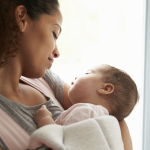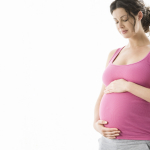Recent studies have demonstrated that more than 10% of women experience clinically significant symptoms of anxiety during pregnancy, particularly during the first trimester. Anxiety during pregnancy is not necessarily a benign event. Various studies indicate that women who experience clinically significant anxiety symptoms during pregnancy are more likely to have preterm labor and low birth weight infants, as well as other complications, including pre-eclampsia. Other studies indicate that exposure to maternal anxiety symptoms may result in programming of the fetal hypothalamic-pituitary-adrenal (HPA) axis, such that exposed children are more likely to experience anxiety and/or depression later on in life.
Thus it is crucial that women with anxiety disorders be monitored carefully during pregnancy. We typically recommend that moderate to severe symptoms of anxiety during pregnancy should be treated with therapy, medication, or a combination of the two.
While we have ample data on the reproductive safety of selective serotonin reuptake inhibitors (SSRIs), including Prozac (fluoxetine) and Celexa (citalopram), which are effective for the treatment of anxiety disorders data regarding the use of benzodiazepines (such as Klonopin, Valium, and Ativan) during pregnancy is far more limited. Nonetheless, one recent study found that 3.9% of American women with private insurance used a benzodiazepine during pregnancy (Hanley et al, 2014).
Dr. Marlene Freeman and colleagues at the Center for Women’s Mental Health have used data from the Massachusetts General Hospital National Pregnancy Registry for Psychiatric Medications which, at the time of this study, included a total of 794 women who were followed prospectively across pregnancy in order to assess neonatal and obstetric outcomes in pregnancies exposed to psychotropic medications. A total of 144 pregnancies exposed to benzodiazepines were identified, and outcomes in this group were compared to a group of 650 women taking part in the registry who had not used benzodiazepines during pregnancy.
The most commonly used benzodiazepine was clonazepam(48.6%, n = 70), followed by lorazepam (43.1%, n= 62). 11 of the 144 participants used more than one benzodiazepine over the course of their pregnancy.
The researchers observed that infants exposed to benzodiazepines in utero were more likely to be admitted to the NICU (OR: 2.02, 95% CI: 1.11, 3.66) and to have small head circumference (OR: 3.89, 95% CI: 1.25, 12.03), as compared to unexposed infants. Other neonatal adverse effects, such as low birth weight, preterm birth, respiratory distress or muscular symptoms including hypotonia were not observed.
These findings are consistent to some degree with previous studies. Increased rates of NICU admission was observed in the report from Calderon-Margalit and colleagues (2009). However, the current study did not find a significant increase in respiratory difficulties, as was observed by Yonkers et al. (2017). In addition, the finding of smaller head circumference is consistent with findings in a case series from Laegreid et al. (1992).
One of the challenges in analyzing and interpreting these findings is that in most cases of benzodiazepine exposure, women were also treated with other psychotropic medications for other psychiatric indications. Women taking benzodiazepines were more likely to receive treatment with atypical antipsychotics, tricyclic antidepressants, anticonvulsants, and sedatives, which may also contribute to neonatal outcomes. There is also data to indicate that, anxiety itself could contribute to neonatal complications, further confounding the results. In addition, the authors note that the effects of benzodiazepine use may differ by timing of use during pregnancy.
Ruta Nonacs, MD PhD
Freeman MP, Góez-Mogollón L, McInerney KA, Davies AC, Church TR, Sosinsky AZ, Noe OB, Viguera AC, Cohen LS. Gen Hosp Psychiatry. 2018 May 29;53:73-79.
Hanley GE, Mintzes B. Patterns of psychotropic medicine use in pregnancy in the United States from 2006 to 2011 among women with private insurance. BMC Pregnancy Childbirth 2014;14:242. h







Your blog is very informative and helpful.Thanks for sharing.